The Economic and Geographical Aspects of the Status of Small-Scale Photovoltaic Systems in Hungary—A Case Study
Abstract
:1. Introduction
1.1. Changes in the Spreading of Photovoltaic Technology
1.2. Hungary’s Feed-In-Tariff System—Overview
1.3. The Economic Indicators of the NUTS2 Regions Hungary
2. Methods and Details of the Study
2.1. The Geographical Scope of the Examination
- Northern Hungary, including the counties Borsod–Abaúj–Zemplén, Heves, and Nógrád;
- The Northern Great Plain, including the counties Hajdú–Bihar, Jász–Nagykun–Szolnok, and Szabolcs–Szatmár–Bereg;
- Pest, including, the county of Pest;
- Budapest, including the capital city of Budapest;
- Central Transdanubia, including the counties Komárom–Esztergom, Fejér, and Veszprém;
- Western Transdanubia, including the counties Győr–Moson–Sopron, Vas, and Zala;
- Southern Transdanubia, including the counties Baranya, Somogy, and Tolna.
2.2. Statistical Analyses of the HMKE Densities in Hungary
2.3. Materials and Methods of the Economic Calculations
- Investors can upgrade to the latest and more efficient PV technologies every 15 years;
3. Results
3.1. Gross HMKE Density in Hungary
3.1.1. Total Gross HMKE Power
3.1.2. Residential Gross HMKE
3.1.3. Business Gross HMKE
3.2. HMKE Density in Hungary Relative to Population Size
3.3. Economic Calculation
4. Conclusions
Author Contributions
Funding
Acknowledgments
Conflicts of Interest
Abbreviations
| a-Si | Amorphous silicon (-) |
| CHP | Combined heat and power plants (-) |
| DPP | Discounted payback period (years) |
| DSO | Distribution System Operator |
| EU | European Union (-) |
| FiT | Feed-in-tariff (€/kWh) |
| HMKE | Household-sized power plants (-) |
| HEA | Hungarian Energy and Public Utility Regulatory Authority (-) |
| IRR | Internal Rate of Return (%) |
| IS | Investment supports (-) |
| KÁT | Renewable Energy Support Scheme until 31 December 2016 (-) |
| m-Si | Monocrystalline silicon (-) |
| METÁR | Renewable Energy Support Scheme from 1 January 2017 (-) |
| NPV | Net present value (€) |
| NS | Net metering system (-) |
| NUTS | Nomenclature of Territorial Units for Statistics Regions (-) |
| P | Power |
| Q | Quantity |
| PV | Photovoltaic (-) |
| p-Si | Polycrystalline silicon (-) |
| PVGIS | JRC Photovoltaic Geographical Information System (-) |
| VRE | Variable renewable energy (-) |
| ZP | Green Premium (-) |
References
- Dominković, D.F.; Bačeković, I.; Sveinbjörnsson, D.; Pedersen, A.S.; Krajačić, G. On the way towards smart energy supply in cities: The impact of interconnecting geographically distributed district heating grids on the energy system. Energy 2017, 137, 941–960. [Google Scholar] [CrossRef] [Green Version]
- Kordmahaleh, A.A.; Naghashzadegan, M.; Javaherdeh, K.; Khoshgoftar, M. Design of a 25 MWe Solar Thermal Power Plant in Iran with Using Parabolic Trough Collectors and a Two-Tank Molten Salt Storage System. Int. J. Photoenergy 2017, 2017, 1–11. [Google Scholar] [CrossRef] [Green Version]
- Noman, A.M.; Addoweesh, K.E.; Alolah, A.I. Simulation and Practical Implementation of ANFIS-Based MPPT Method for PV Applications Using Isolated Ćuk Converter. Int. J. Photoenergy 2017, 2017, 1–15. [Google Scholar] [CrossRef] [Green Version]
- Daliento, S.; Chouder, A.; Guerriero, P.; Pavan, A.M.; Mellit, A.; Moeini, R.; Tricoli, P. Monitoring, Diagnosis, and Power Forecasting for Photovoltaic Fields: A Review. Int. J. Photoenergy 2017, 2017, 1–13. [Google Scholar] [CrossRef]
- Sefa, İ.; Demirtas, M.; Çolak, İ. Application of one-axis sun tracking system. Energy Convers. Manag. 2009, 50, 2709–2718. [Google Scholar] [CrossRef]
- Nengroo, S.; Kamran, M.; Ali, M.; Kim, D.-H.; Kim, M.-S.; Hussain, A.; Kim, H.; Nengroo, S.H.; Kamran, M.A.; Ali, M.U.; et al. Dual Battery Storage System: An Optimized Strategy for the Utilization of Renewable Photovoltaic Energy in the United Kingdom. Electronics 2018, 7, 177. [Google Scholar] [CrossRef] [Green Version]
- Turner, J.A. A realizable renewable energy future. Science 1999, 285, 687–689. [Google Scholar] [CrossRef] [Green Version]
- Lin, A.; Lu, M.; Sun, P.; Lin, A.; Lu, M.; Sun, P. The Influence of Local Environmental, Economic and Social Variables on the Spatial Distribution of Photovoltaic Applications across China’s Urban Areas. Energies 2018, 11, 1986. [Google Scholar] [CrossRef] [Green Version]
- Liu, Z.; Wu, D.; Yu, H.; Ma, W.; Jin, G. Field measurement and numerical simulation of combined solar heating operation modes for domestic buildings based on the Qinghai–Tibetan plateau case. Energy Build. 2018, 167, 312–321. [Google Scholar] [CrossRef]
- Alsafasfeh, M.; Abdel-Qader, I.; Bazuin, B.; Alsafasfeh, Q.; Su, W.; Alsafasfeh, M.; Abdel-Qader, I.; Bazuin, B.; Alsafasfeh, Q.; Su, W. Unsupervised Fault Detection and Analysis for Large Photovoltaic Systems Using Drones and Machine Vision. Energies 2018, 11, 2252. [Google Scholar] [CrossRef] [Green Version]
- Hosenuzzaman, M.; Rahim, N.A.; Selvaraj, J.; Hasanuzzaman, M.; Malek, A.B.M.A.; Nahar, A. Global prospects, progress, policies, and environmental impact of solar photovoltaic power generation. Renew. Sustain. Energy Rev. 2015, 41, 284–297. [Google Scholar] [CrossRef]
- Roth, W. General Concepts of Photovoltaic Power Supply Systems; Fraunhofer Institute for Solar Energy Systems ISE: Freiburg, Germany, 2005; pp. 1–23. [Google Scholar]
- Kumar Sahu, B. A study on global solar PV energy developments and policies with special focus on the top ten solar PV power producing countries. Renew. Sustain. Energy Rev. 2015, 43, 621–634. [Google Scholar] [CrossRef]
- Vokas, G.A.; Zoridis, G.C.; Lagogiannis, K.V. Single and Dual Axis PV Energy Production Over Greece: Comparison Between Measured and Predicted Data. Energy Procedia 2015, 74, 1490–1498. [Google Scholar] [CrossRef] [Green Version]
- Green, M.A.; Dunlop, E.D.; Levi, D.H.; Hohl-Ebinger, J.; Yoshita, M.; Ho-Baillie, A.W.Y. Solar cell efficiency tables (version 54). Prog. Photovolt. 2019, 27, 565–575. [Google Scholar] [CrossRef]
- Eke, R.; Senturk, A. Performance comparison of a double-axis sun tracking versus fixed PV system. Sol. Energy 2012, 86, 2665–2672. [Google Scholar] [CrossRef]
- Rena Projekt Kft. 500 kW Small-Scale or KÁT PV System System Technical Information’s and Prices in Hungary. Available online: https://renasolar.hu/arak.html (accessed on 7 January 2020).
- Solargis.com. Solar Resource Maps and GIS Data for 200+ Countries. Available online: https://solargis.com/products/maps-and-gis-data/download/ (accessed on 4 February 2020).
- Bai, A.; Popp, J.; Balogh, P.; Gabnai, Z.; Pályi, B.; Farkas, I.; Pintér, G.; Zsiborács, H. Technical and economic effects of cooling of monocrystalline photovoltaic modules under Hungarian conditions. Renew. Sustain. Energy Rev. 2016, 60, 1086–1099. [Google Scholar] [CrossRef] [Green Version]
- Zsiborács, H.; Pályi, B.; Pintér, G.; Popp, J.; Balogh, P.; Gabnai, Z.; Pető, K.; Farkas, I.; Baranyai, N.H.; Bai, A. Technical-economic study of cooled crystalline solar modules. Sol. Energy 2016, 140, 227–235. [Google Scholar] [CrossRef] [Green Version]
- Benick, J.; Richter, A.; Muller, R.; Hauser, H.; Feldmann, F.; Krenckel, P.; Riepe, S.; Schindler, F.; Schubert, M.C.; Hermle, M.; et al. High-Efficiency n-Type HP mc Silicon Solar Cells. IEEE J. Photovolt. 2017, 7, 1171–1175. [Google Scholar] [CrossRef]
- Cosme, I.; Cariou, R.; Chen, W.; Foldyna, M.; Boukhicha, R.; Roca i Cabarrocas, P.; Lee, K.D.; Trompoukis, C.; Depauw, V. Lifetime assessment in crystalline silicon: From nanopatterned wafer to ultra-thin crystalline films for solar cells. Sol. Energy Mater. Sol. Cells 2015, 135, 93–98. [Google Scholar] [CrossRef]
- Green, M.A.; Emery, K.; Hishikawa, Y.; Warta, W.; Dunlop, E.D. Solar cell efficiency tables (version 48). Prog. Photovolt. Res. Appl. 2016, 24, 905–913. [Google Scholar] [CrossRef] [Green Version]
- International Energy Agency. Technology Roadmap Solar Photovoltaic Energy—2014 Edition; International Energy Agency: Paris, France, 2014; pp. 1–60. [Google Scholar]
- Krempasky, J. Semiconductors, Questions & Answers; Technical Publishing House: Budapest, Hungary, 1977. [Google Scholar]
- Verlinden, P.; Deng, W.; Zhang, X.; Yang, Y.; Xu, J.; Shu, Y.; Quan, P.; Sheng, J.; Zhang, S.; Bao, J. Strategy, development and mass production of high-efficiency crystalline Si PV modules. In Proceedings of the 6th World Conference on Photovoltaic Energy Conversion, Kyoto, Japan, 23–27 November 2014. [Google Scholar]
- SecondSol Inc. New and Used PV Module Prices. Available online: https://www.secondsol.com/en/categories/Photovoltaic-Modules_40939 (accessed on 7 April 2020).
- Kondo, M.; Yoshida, I.; Saito, K.; Matsumoto, M.; Suezaki, T.; Sai, H.; Matsui, T. Development of Highly Stable and Efficient Amorphous Silicon Based Solar Cells. In Proceedings of the 28th European Photovoltaic Solar Energy Conference and Exhibition, WIP, Villepinte, France, 30 September–4 October 2013; pp. 2213–2217. [Google Scholar]
- ÖKO-HAUS GmbH. Information on the Prices of a-Si Solar Modules, Price Quotation. Available online: https://www.oeko-haus.com/ (accessed on 19 February 2018).
- REN21. Renewables 2018 Global Status Report—REN21; REN21: Paris, France, 2018. [Google Scholar]
- Enjavi-Arsanjani, M.; Hirbodi, K.; Yaghoubi, M. Solar Energy Potential and Performance Assessment of CSP Plants in Different Areas of Iran. Energy Procedia 2015, 69, 2039–2048. [Google Scholar] [CrossRef] [Green Version]
- Statista, I. Cumulative Solar Photovoltaic Capacity Globally as of 2017, by Select Country (in gigawatts). Available online: https://www.statista.com/statistics/264629/existing-solar-pv-capacity-worldwide/ (accessed on 12 January 2020).
- PV magazine. Hungary to see Record PV Growth in 2018. Available online: https://www.pv-magazine.com/2018/09/12/hungary-to-see-record-pv-growth-in-2018/ (accessed on 11 November 2019).
- Hungarian Transmission System Operator—MAVIR ZRt. Renewable Support Department Customer Service. Available online: https://www.mavir.hu/web/mavir/ugyfelszolgalat (accessed on 18 October 2019).
- Fülöp Miklós. Működik Az Első Hazai Közcélú Energiatároló Egység. Available online: https://www.villanylap.hu/hirek/4904-mukodik-az-elso-hazai-kozcelu-energiatarolo-egyseg (accessed on 20 February 2019).
- Igazságügyi Minisztérium. Magyar Közlöny, 2019. Évi 222. Szám; Gazságügyi Minisztérium: Budapest, Hungary, 2019. [Google Scholar]
- Magyar Villamosenergia-ipari Átviteli Rendszerirányító Zártkörűen Működő Részvénytársaság (MAVIR ZRt.). A Magyar VER Fogyasztói és forrásoldali Jövőképe 2020–2040—Input Adatok; Magyar Villamosenergia-ipari Átviteli Rendszerirányító Zártkörűen Működő Részvénytársaság (MAVIR ZRt.): Budapest, Hungary, 2020. [Google Scholar]
- Fraunhofer Institute for Solar Energy Systems. Photovoltaics Report; Fraunhofer Institute for Solar Energy Systems: Freiburg, Germany, 2019. [Google Scholar]
- La Monaca, S.; Ryan, L. Solar PV where the sun doesn’t shine: Estimating the economic impacts of support schemes for residential PV with detailed net demand profiling. Energy Policy 2017, 108, 731–741. [Google Scholar] [CrossRef] [Green Version]
- European Commission. RES LEGAL Europe. Available online: http://www.res-legal.eu/ (accessed on 13 November 2019).
- Coria, G.; Penizzotto, F.; Pringles, R. Economic analysis of photovoltaic projects: The Argentinian renewable generation policy for residential sectors. Renew. Energy 2018, 133, 1167–1177. [Google Scholar] [CrossRef]
- European Commission. Legal Sources on Renewable Energy—Hungary. Available online: http://www.res-legal.eu/en/search-by-country/hungary/ (accessed on 2 February 2020).
- Sorknæs, P.; Djørup, S.R.; Lund, H.; Thellufsen, J.Z. Quantifying the influence of wind power and photovoltaic on future electricity market prices. Energy Convers. Manag. 2019, 180, 312–324. [Google Scholar] [CrossRef]
- Zsiborács, H.; Hegedűsné Baranyai, N.; Csányi, S.; Vincze, A.; Pintér, G. Economic Analysis of Grid-Connected PV System Regulations: A Hungarian Case Study. Electronics 2019, 8, 149. [Google Scholar] [CrossRef] [Green Version]
- European Commission. RES REGAL. Legal Sources on Renewable Energy, Feed-In Tariff (EEG Feed-In Tariff), Germany. Available online: http://www.res-legal.eu/search-by-country/germany/single/s/res-e/t/promotion/aid/feed-in-tariff-eeg-feed-in-tariff/lastp/135/ (accessed on 4 February 2020).
- Pintér, G.; Baranyai, N.H.; Wiliams, A.; Zsiborács, H. Study of photovoltaics and LED energy efficiency: Case study in Hungary. Energies 2018, 11, 790. [Google Scholar]
- Hungarian Transmission System Operator—MAVIR ZRt. Useful Documents to KÁT System. Available online: https://www.mavir.hu/web/mavir/ugyfelszolgalat (accessed on 2 February 2020).
- E.ON Hungária Zrt. House-Hold-Sized Power Plants (HMKE). Available online: http://energia.eon.hu/hmke/# (accessed on 2 February 2020).
- Tiszta Energiák Kft. Information About the Small-Scale PV System Tiszta Energiák Kft. Available online: https://www.tisztaenergiak.hu/ (accessed on 11 October 2019).
- D’Adamo, I. The Profitability of Residential Photovoltaic Systems. A New Scheme of Subsidies Based on the Price of CO2 in a Developed PV Market. Soc. Sci. 2018, 7, 148. [Google Scholar]
- Pintér, G.; Birkner, Z.; Hegedűsné Baranyai, N.; Zsiborács, H. A hazai energiatárolás lehetőségei 2030-ig—Possibilities of energy storage systems in Hungary until 2030. Energiagazdálkodás 2019, 2019, 1–44. [Google Scholar]
- Hungarian Central Statistical Office STADAT. Available online: http://www.ksh.hu/stadat (accessed on 1 May 2020).
- Freedman, D.; Pisani, R.; Purves, R. Statistics; Typotex: Budapest, Hungary, 2005; ISBN 10 963-9548-63-4; 13 978-963-9548-63-3. [Google Scholar]
- Zsiborács, H.; Pályi, B.; Pintér, G.; Baranyai, N.H.; Szabó, P.; Farkas, I. Economic questions and energy performance of the cooled polycrystalline solar photovoltaic (PV) technology. Rev. Agric. Rural Dev. 2016, 5, 162–170. [Google Scholar]
- Kocsis, K.; Schweitzer, F. Hungary in Maps; Geographical Institute, Research Centre for Astronomy and Earth Sciences of the Hungarian Academy of Sciences: Budapest, Hungary, 2011. [Google Scholar]
- Jordan, D.C.; Kurtz, S.R. Photovoltaic Degradation Rates-an Analytical Review. Prog. Photovolt. Res. Appl. 2013, 21, 12–29. [Google Scholar] [CrossRef] [Green Version]
- SecondSol Inc. New and Used Inverter Prices. Available online: https://www.secondsol.com/en/categories/Inverters_40948 (accessed on 7 March 2020).
- Brealey, R.A.; Myers, S.C.; Allen, F.; Mohanty, P. Principles of Corporate Finance; McGraw-Hill/Irwin: New York, NY, USA, 2003. [Google Scholar]
- European Commission. JRC Photovoltaic Geographical Information System (PVGIS). Available online: http://re.jrc.ec.europa.eu/pvg_tools/en/tools.html#PVP (accessed on 1 May 2020).
- SMA Solar Technology AG. ZMET PV System Profile. Available online: https://www.sunnyportal.com/Templates/PublicPageOverview.aspx?page=96e1e167-9121-42c5-8f5c-bae1923c6a85&plant=a2fa17c6-7f5c-4b13-8a61-3a83f77e5d84&splang=en-US (accessed on 29 March 2020).
- SMA Solar Technology AG. Pitvaros 1 PV System Profile. Available online: https://www.sunnyportal.com/Templates/PublicPageOverview.aspx?page=07f487db-8b6a-4e9c-aa43-7992c5957656&plant=88dd56e3-63c5-4aa6-9926-2a1948b65854&splang=en-US (accessed on 29 May 2020).
- SMA Solar Technology AG. CZK-001 PV System Profile. Available online: https://www.sunnyportal.com/Templates/PublicPageOverview.aspx?page=afeb0fab-f6db-4b82-8782-49ac359e5f13&plant=934c0200-15f1-4e6c-8100-b9f5a02912c0&splang=en-US (accessed on 29 May 2020).
- Investing.com. European Government Bonds Yields. Available online: https://www.investing.com/rates-bonds/european-government-bonds?maturity_from=10&maturity_to=310 (accessed on 1 May 2020).
- Inflation.eu. Historic Inflation Hungary—Historic CPI Inflation Hungary. Available online: http://www.inflation.eu/inflation-rates/hungary/historic-inflation/cpi-inflation-hungary.aspx (accessed on 1 May 2020).
- E.ON Hungária Zrt. Average Delivery Price for Electric Energy for Business Customer in the HMKE System and in the Small-Scale PV System. Available online: https://www.eon.hu/hu/uzleti/aram/arak-tarifadijak.html (accessed on 1 May 2020).
- E.ON Hungária Zrt. Household-Size Power Plants (HMKE) Documentation; E.ON Hungária Zrt.: Budapest, Hungary, 2018. [Google Scholar]
- Kacira, M.; Simsek, M.; Babur, Y.; Demirkol, S. Determining optimum tilt angles and orientations of photovoltaic panels in Sanliurfa, Turkey. Renew. Energy 2004, 29, 1265–1275. [Google Scholar] [CrossRef]
- Breyer, C.; Schmid, J. Global Distribution of Optimal Tilt Angles for Fixed Tilted PV Systems. In Proceedings of the 25th European Photovoltaic Solar Energy Conference and Exhibition 5th World Conference on Photovoltaic Energy Conversion, Valencia, Spain, 6–10 September 2010; pp. 4715–4721. [Google Scholar]
- SMA Solar Technology AG. PV System in Hungary, 1945.01 kWp, Berettyóújfalu_13. Available online: https://www.sunnyportal.com/Templates/PublicPageOverview.aspx?page=3bb31f01-cf47-49f8-852f-11ea28e0bd1c&plant=3a1a11db-35f9-41d5-9837-56c4ac252d90&splang=en-US (accessed on 29 May 2020).
- Stabil Invest Kft. The Price of a 5 kWp Complete PV System in Hungary. Available online: http://www.stabil-invest.hu/termek/growatt-inverteres-rendszer-napelemhez/5kw-napelem-rendszer-egy-fazisra-kulcsrakesz/ (accessed on 2 February 2020).
- Stabil Invest Kft. The Price of a 15 kWp Complete PV System in Hungary. Available online: http://www.stabil-invest.hu/termek/growatt-inverteres-rendszer-napelemhez/15kw-napelem-rendszer-kulcsrakesz/ (accessed on 30 May 2020).
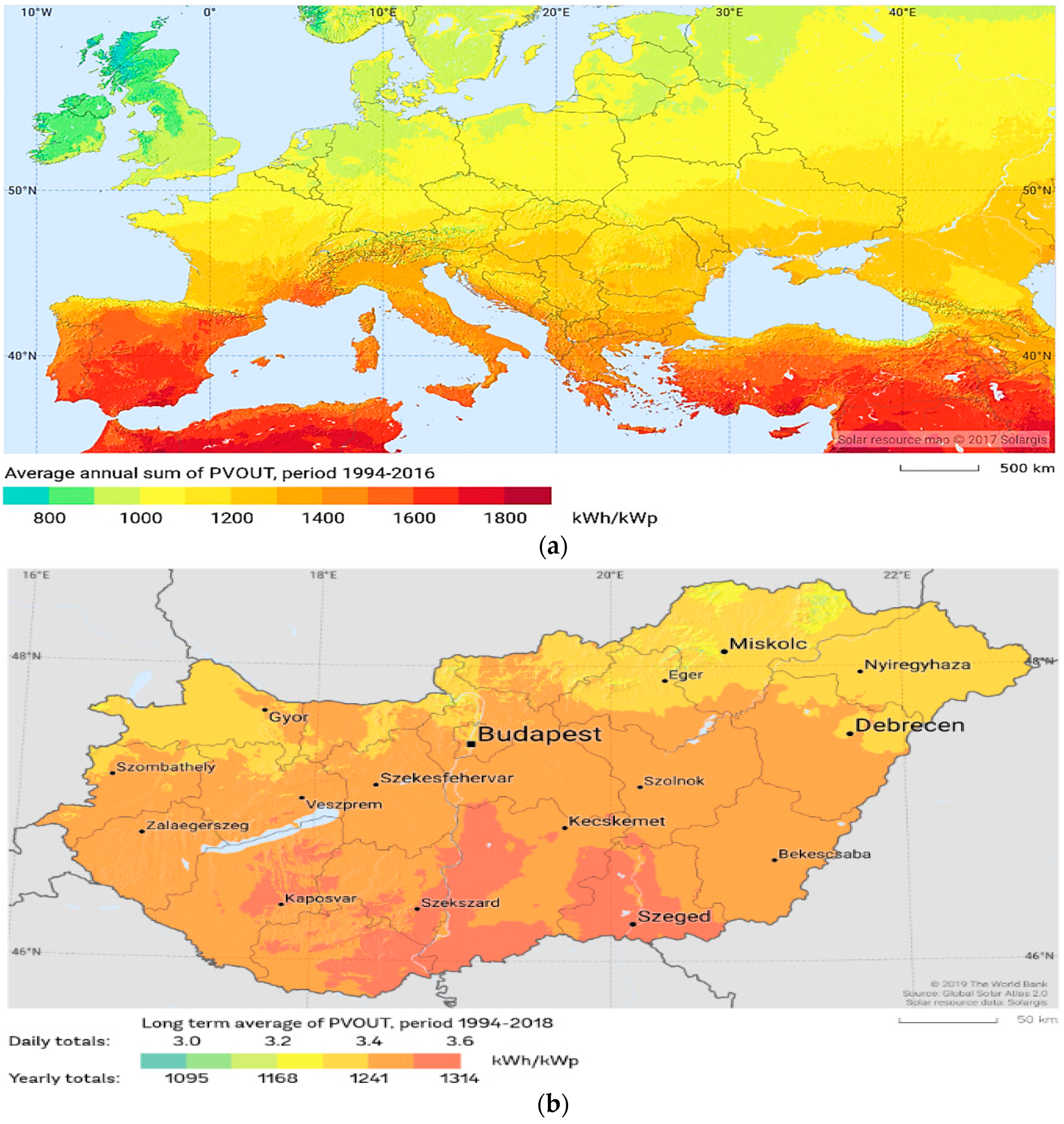

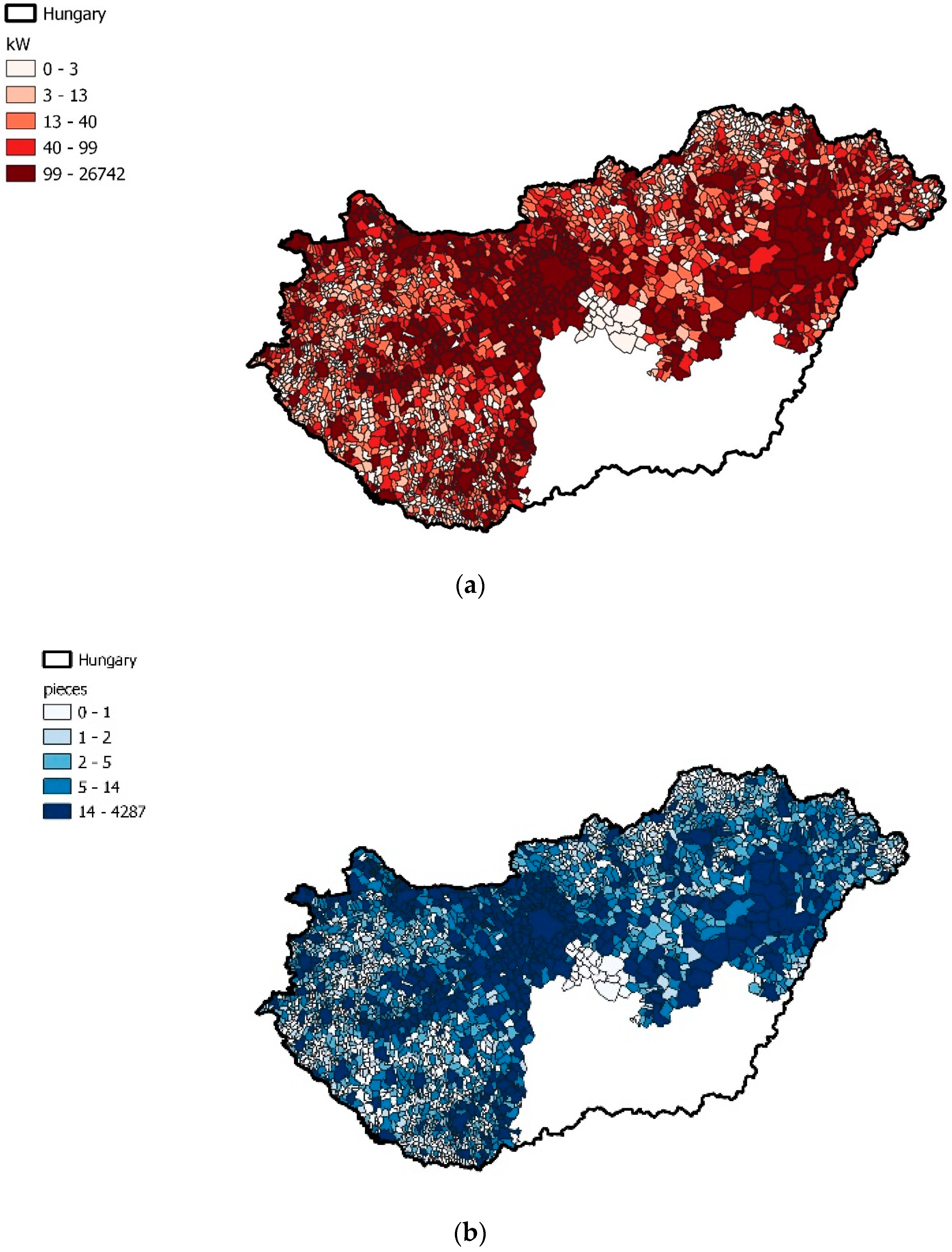

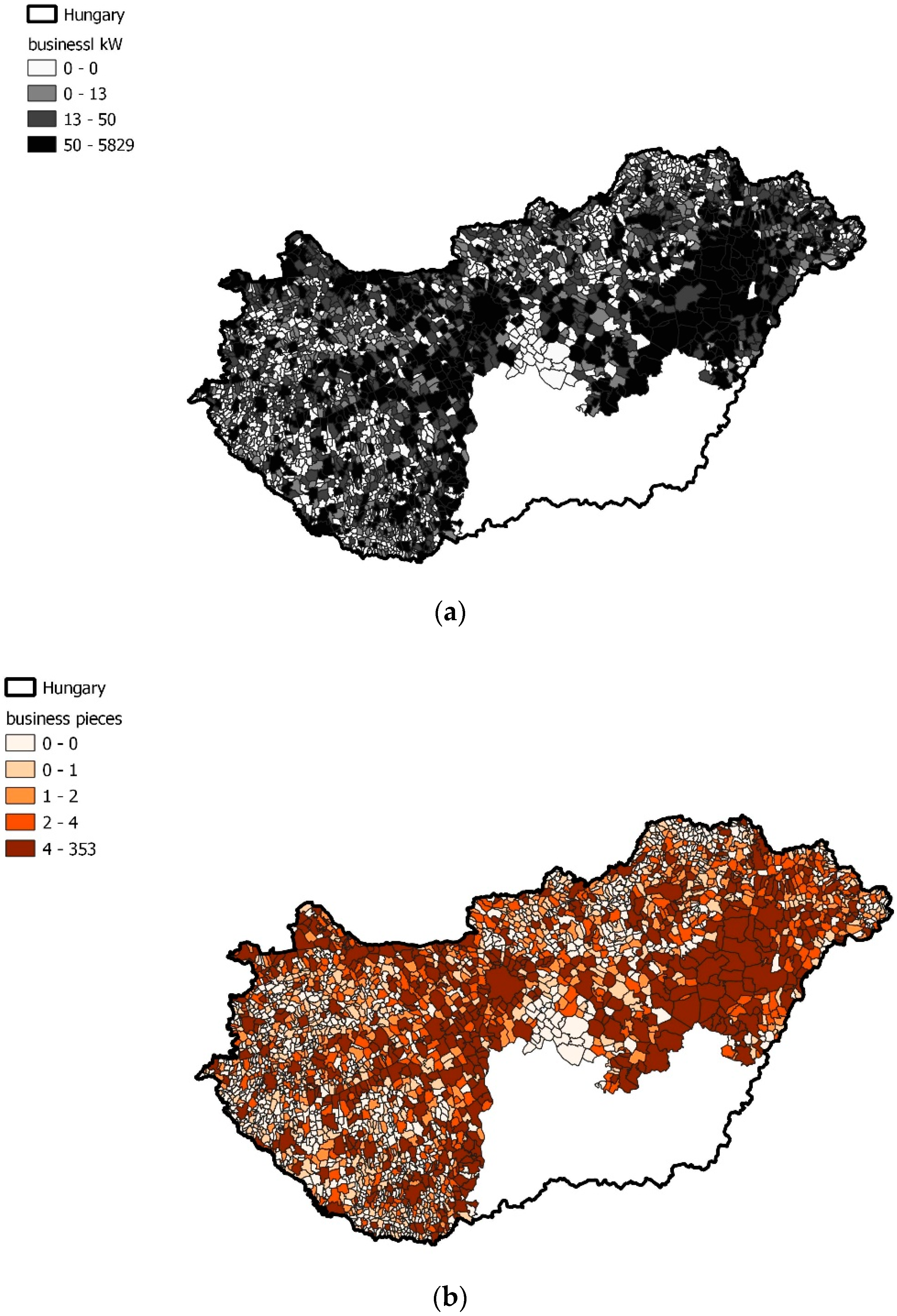

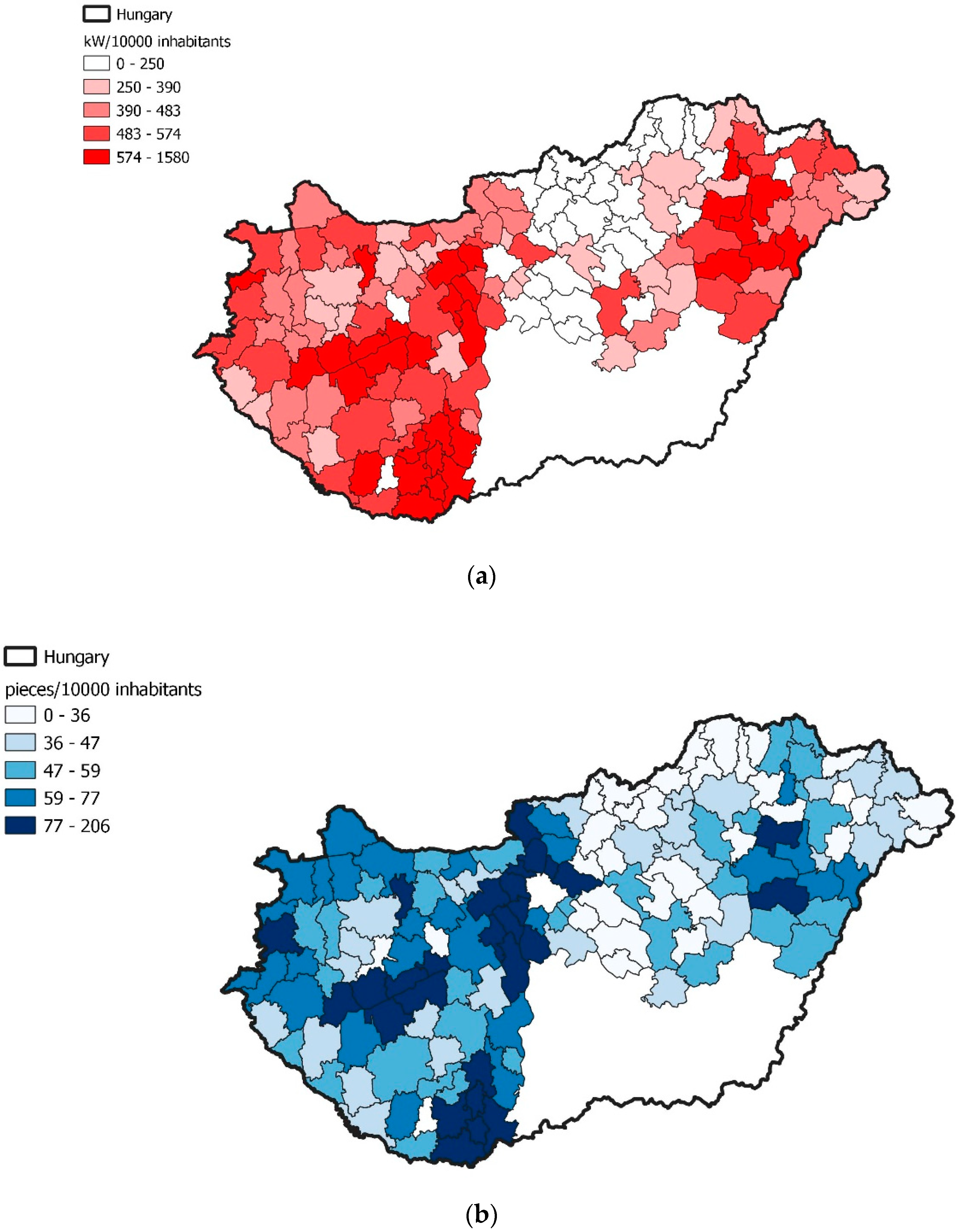
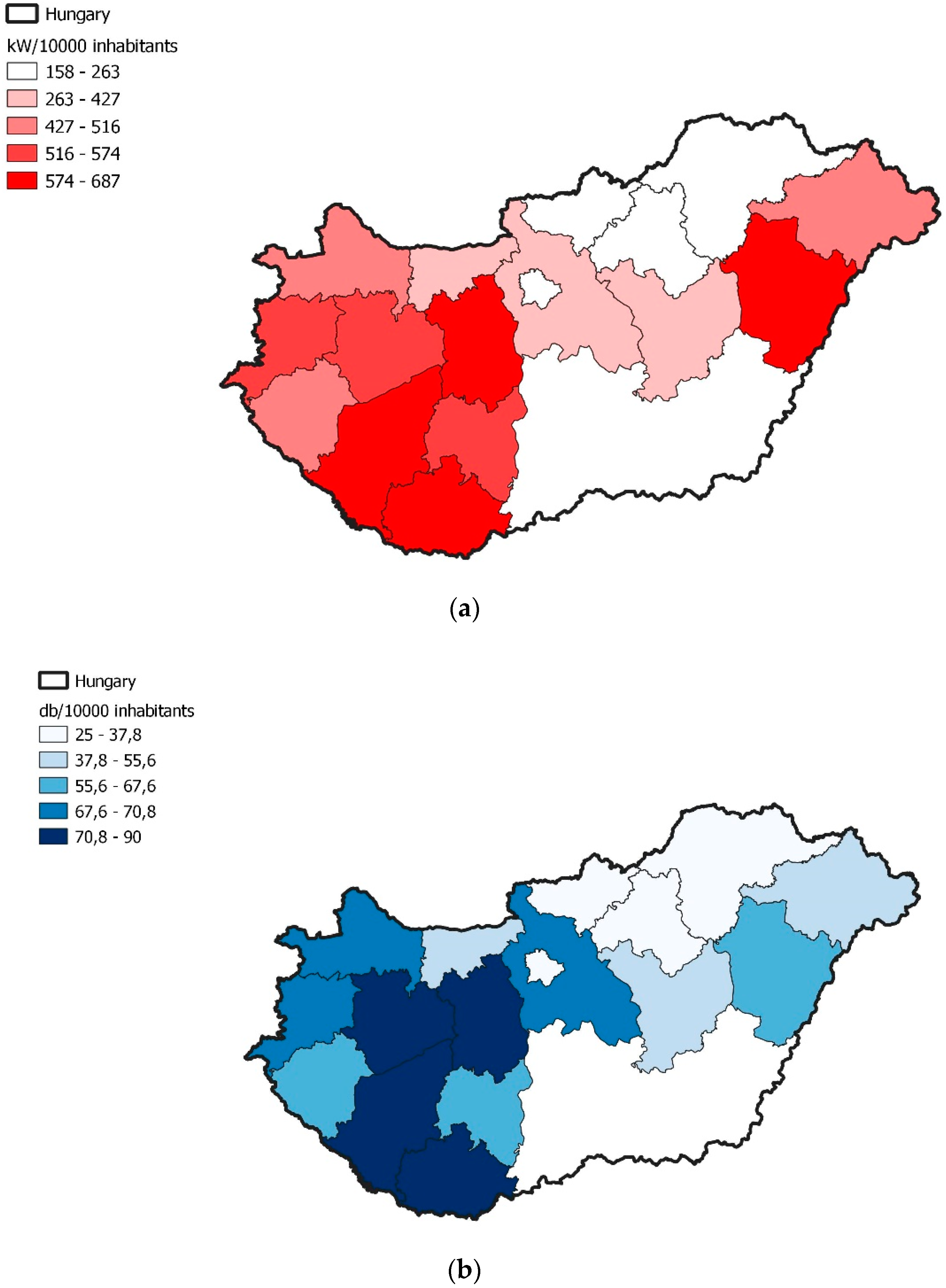
| Region/Economic Indicator | Southern Transdanubia | Northern Great Plain | Northern Hungary | Central Transdanubia | Western Transdanubia | Pest | Budapest |
|---|---|---|---|---|---|---|---|
| GDP/capita [thousand HUF *] | 3001 | 3010 | 2804 | 4024 | 4419 | 3460 | 8886 |
| Average monthly gross earnings [HUF] | 244,300 | 243,074 | 229,826 | 280,603 | 280,640 | 272,948 | 375,881 |
| Population | 879,596 | 1,450,960 | 1,126,360 | 1,058,236 | 989,343 | 1,278,874 | 1,752,286 |
| Number of enterprises | 170,277 | 288,317 | 165,484 | 175,563 | 189,764 | 230,675 | 455,144 |
| Content | Value |
|---|---|
| Average validated electric energy production of a 1 kWp HMKE PV system in Hungary, first-year (kWh/a) | 1200 |
| Decrease in the annual performance of average crystalline modules after the 1st year (%) | 0.5 |
| Duration of the investment (year) | 15 |
| System loss (PV inverter, grid) (%) | 10 |
| Tilt angle of PV modules (°) | 35 |
| Orientation (azimuth) (°) | 180 |
| Average PV system of an HMKE residential customer (see calculation in Chapter Results) (kWp) | 5 |
| Average PV system of an HMKE business customer (see calculation in Chapter Results) (kWp) | 15 |
| Average delivery price for electric energy for business customers in the HMKE PV system, net (€/kWh/2020) | 0.136 |
| Average delivery price for electric energy for residential customers in the HMKE PV system, gross (€/kWh/2020) | 0.100 |
| Rate of average inflation (2005–2019) (%) | 3.37 |
| Bond yield interest rate (%) | 2.775 |
| Financial support (%) | 0 |
| Investment costs, 5 kWp residential HMKE PV system, gross, 2020 (€) | 4535 |
| Investment costs, 15 kWp business HMKE PV system, net, 2020 (€) | 7985 |
| Average price of 1 kWp used crystalline PV modules, gross, 2020 (€) | 100 |
| Average price of 5 kW used PV inverter power, HMKE, gross, 2020 (€) | 300 |
| Average price of 15 kW used PV inverter power, HMKE, net, 2020 (€) | 500 |
| REGION/HMKE | Southern Transdanubia | Northern Great Plain | Northern Hungary | Central Transdanubia | Western Transdanubia | Pest | Budapest City | Average |
|---|---|---|---|---|---|---|---|---|
| P average [kW] | 8 | 9 | 6 | 7 | 8 | 5 | 6 | 7 |
| P average business [kW] | 15 | 16 | 11 | 15 | 15 | 13 | 16 | 15 |
| P average residential [kW] | 6 | 6 | 5 | 6 | 6 | 5 | 5 | 5 |
| REGION/HMKE | Southern Transdanubia | Northern Great Plain | Northern Hungary | Central Transdanubia | Western Transdanubia | Pest | Budapest City |
|---|---|---|---|---|---|---|---|
| P total [kW] | 57,966 | 73,529 | 27,098 | 56,731 | 50,156 | 46,458 | 26,742 |
| P residential [KW] | 29,912 | 34,192 | 14,347 | 36,797 | 29,535 | 39,180 | 21,221 |
| P business [kW] | 28,054 | 39,338 | 12,751 | 19,934 | 20,621 | 7278 | 5521 |
| Q * total [pieces] | 7244 | 8010 | 4171 | 7771 | 6680 | 8609 | 4287 |
| Q * residential [pieces] | 5432 | 5619 | 2966 | 6404 | 5274 | 8047 | 3927 |
| Q * business [pieces] | 1812 | 2391 | 1201 | 1367 | 1406 | 548 | 353 |
| REGION/HMKE | Southern Transdanubia | Northern Great Plain | Northern Hungary | Central Transdanubia | Western Transdanubia | Pest | Budapest City | Average |
|---|---|---|---|---|---|---|---|---|
| P total/10,000 inhabitants [kW] | 659 | 653 | 187 | 536 | 507 | 363 | 153 | 437 |
| P residential/10,000 inhabitants [kW] | 340 | 304 | 99 | 348 | 299 | 306 | 121 | 259 |
| P business/10,000 inhabitants [kW] | 319 | 349 | 88 | 188 | 208 | 57 | 32 | 177 |
| Q total/10,000 inhabitants [pieces] | 82 | 71 | 29 | 73 | 68 | 67 | 24 | 59 |
| Q residential/10,000 inhabitants [pieces] | 62 | 50 | 20 | 61 | 53 | 63 | 22 | 47 |
| Q business/10,000 inhabitants [pieces] | 21 | 21 | 8 | 13 | 14 | 4 | 2 | 12 |
| REGION/HMKE | Southern Transdanubia | Northern Great Plain | Northern Hungary | Central Transdanubia | Western Transdanubia | Pest | Budapest City | Average |
|---|---|---|---|---|---|---|---|---|
| GDP/capita [thousand HUF] | 3001 | 3010 | 2804 | 4024 | 4419 | 3460 | 8886 | 4229 |
| Industrial production/capita [thousand HUF] | 1998 | 2529 | 4170 | 6372 | 6561 | 2660 | 2131 | 3775 |
| Population density [pop./km2] | 62 | 82 | 84 | 95 | 87 | 200 | 3337 | - |
| Number of enterprises/1000 people | 194 | 199 | 147 | 166 | 192 | 180 | 260 | 191 |
| Average monthly gross earnings [HUF] | 244,300 | 243,074 | 229,826 | 280,603 | 280,640 | 272,948 | 375,881 | 275,325 |
| REGION/HMKE | Southern Transdanubia | Northern Great Plain | Northern Hungary | Central Transdanubia | Western Transdanubia | Pest | Budapest City | Average |
|---|---|---|---|---|---|---|---|---|
| P business/10,000 Businesses [kW] | 1648 | 2377 | 442 | 1135 | 1087 | 315 | 121 | 1018 |
| Q business/10,000 businesses [pieces] | 106 | 144 | 42 | 78 | 74 | 24 | 8 | 68 |
| Indicators | P Total/10,000 Inhabitants | P Residential/10,000 Inhabitants | P Business/10,000 Inhabitants | Q Total/10,000 Inhabitants | Q Residential/10,000 Inhabitants | Q Business/10,000 Inhabitants | P Business/10,000 Businesses | Q Business/10,000 Businesses |
|---|---|---|---|---|---|---|---|---|
| GDP/capita | −0.545/0.206 | −0.462/0.297 | −0.521/0.231 | −0.581/0.171 | −0.478/0.277 | −0.580/0.172 | −0.509/0.243 | −0.572/0.180 |
| Industrial production/capita | 0.097/0.836 | 0.206/0.657 | −0.010/0.983 | 0.157/0.737 | 0.160/0.731 | 0.053/0.911 | −0.030/0.949 | 0.032/0.946 |
| Population density | −0.613/0.143 | −0.584/0.169 | −0.533/0.219 | −0.677/0.095 | −0.590/0.163 | −0.594/0.159 | −0.510/0.243 | −0.576/0.176 |
| Number of enterprises/1000 people | −0.177/0.705 | −0.207/0.656 | −0.121/0.797 | −0.280/0.543 | −0.250/0.588 | −0.217/0.641 | −0.111/0.813 | −0.201/0.665 |
| Average monthly gross earnings | −0.493/0.261 | −0.328/0.472 | −0.545/0.205 | −0.471/0.286 | −0.327/0.474 | −0.611/0.145 | −0.530/0.222 | −0.596/0.158 |
| Content | Values | |
|---|---|---|
| Studied investment period (years) | 15 | |
| Studied PV economic environment | HMKE | |
| Type of prosumer | residential | business |
| Average system size (kWp) | 5 | 15 |
| Value-added tax | gross | net |
| Investment costs, 2020 (€) | 4535 | 7985 |
| Negative cash flow (CO&M,total + Demolition fee), net (€) | 3619 | 3232 |
| Positive cash flow, (€) | 12,066 | 47,636 |
| Net present value (NPV) (€) | 2088 | 27,211 |
| Internal rate of return (IRR) (%) | 7.7 | 31.3 |
| Discounted payback period (DPP) (year) | 12 | 4 |
© 2020 by the authors. Licensee MDPI, Basel, Switzerland. This article is an open access article distributed under the terms and conditions of the Creative Commons Attribution (CC BY) license (http://creativecommons.org/licenses/by/4.0/).
Share and Cite
Pintér, G.; Zsiborács, H.; Hegedűsné Baranyai, N.; Vincze, A.; Birkner, Z. The Economic and Geographical Aspects of the Status of Small-Scale Photovoltaic Systems in Hungary—A Case Study. Energies 2020, 13, 3489. https://doi.org/10.3390/en13133489
Pintér G, Zsiborács H, Hegedűsné Baranyai N, Vincze A, Birkner Z. The Economic and Geographical Aspects of the Status of Small-Scale Photovoltaic Systems in Hungary—A Case Study. Energies. 2020; 13(13):3489. https://doi.org/10.3390/en13133489
Chicago/Turabian StylePintér, Gábor, Henrik Zsiborács, Nóra Hegedűsné Baranyai, András Vincze, and Zoltán Birkner. 2020. "The Economic and Geographical Aspects of the Status of Small-Scale Photovoltaic Systems in Hungary—A Case Study" Energies 13, no. 13: 3489. https://doi.org/10.3390/en13133489




